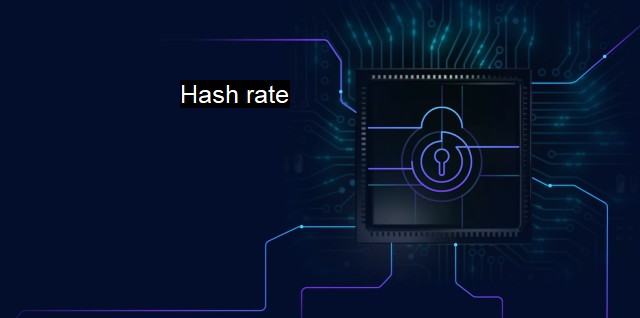What is Hash rate?
Exploring the Significance of Hash Rate in Cybersecurity and its Interplay with Antivirus Software: A Comprehensive Overview
A "hash rate" is a quantifiable measure usually associated with the functions of cryptocurrency mining and cybersecurity. It is relevant in the systems design of cryptocurrencies, like Bitcoin, and plays a vital role in antivirus programming as well. This explanation will help you grasp better the meaning of "hash rate" and its significant contribution both in cryptocurrencies computation and cybersecurity.The term "hash rate" can be linked back to what is known as a cryptographic hash function. A hash function is an algorithm that transforms any data into a unique, fixed-length string of symbols. This is crucial because it helps maintain the integrity and the security of the data. It ensures the data remains untouched during transmission, meaning it isn’t tampered with or changed mysteriously.
Speaking about hash rate in the bounds of cryptocurrency mining; mining involves validating new transactions and recording them on a global ledger known as the blockchain. To add a block of transactions to the blockchain, miners must solve complex mathematical problems. These problems involve guesses, and these guesses are made by performing hashing operations. The speed at which these operations are performed is known as hash rate.
More accurately, the hash rate is the speed at which a cryptocurrency miner's hardware can make those guesses to solve the cryptographic problem. It is usually measured in "hash per second.(H/s)" because of the high speed of computing, you will mostly encounter kilohash (KH/s), megahash (MH/s), gigahash (GH/s), or even terahash (TH/s) and petahash (PH/s). For instance, a miner with a hash rate of 1GH/s can make a billion calculations per second.
A higher hash rate increases the chance of solving the block and winning associated mining rewards because a high hash rate allows a miner to make more guesses per second than a low hash rate. So, from the cryptocurrency mining perspective, a higher hash rate is undeniably beneficial.
On the other hand, hash rate's computation is also significant for antivirus software as they use it to identify viruses and protect data. Antivirus programs use hashing to harden security networks, protect data databases, secure Severs, Networks and Websites from adversarial attacks (DoS & DDoS attacks). Here is how it works:
Basically, antivirus programs function by running a hash of the file and comparing that hash with an enormous database of known viruses. Antivirus software regularly scans each file on your computer or in transmission to the computer and converts it into a hash. The antivirus then compares the file’s hash to its library of known virus hashes.
If the hash of the file matches a virus’s hash in the antivirus’s library, the antivirus identifies the file as dangerous and takes the necessary action to remove the threat. This kind of security measurement makes the antivirus more accurate and reliable when dealing with virus protection. hashing each file can help immensely in data integrity checks. If a file’s hash differs from what it was originally, it indicates a change in the data, further pointing towards signs of unauthorized access or potential security threats.
Hash rates are pivotal whether it's cryptocurrency mining or the cybersecurity universe. For cryptocurrency mining, the hash rate not only reflects the potential earning capacity of a miner but also illustrates the level of competitiveness hidden in the 'stratum'. On the contrary eq=uipping antivirus software with hashes protects the integrity, security and sanctity of our data, fending off possible malicious attacks. Therefore, understanding the hash rate conceives the rationale behind successful crypto mining and the implementation of preventive antivirus measures.

Hash rate FAQs
What is hash rate?
Hash rate refers to the speed at which a computer is able to solve a cryptographic puzzle to verify transactions on a blockchain network. In the context of cybersecurity and antivirus, it is an indicator of the computational power required to mine or crack cryptographic hashes.Why is hash rate important in cyber security?
Hash rate is important in cybersecurity because it determines the computational power required to launch a successful attack on a blockchain network or password-protected systems. It is also used to measure the strength and effectiveness of antivirus software in detecting and blocking malicious files and programs.What factors affect hash rate?
Some of the factors that affect hash rate include the processing power of a computer, the type of hardware used, the level of optimization of the software being used, and the difficulty of the cryptographic puzzle being solved. Other factors that may affect hash rate include temperature, energy consumption, and network congestion.How can hash rate be improved?
There are several ways to improve hash rate, including upgrading hardware, optimizing software configurations, reducing energy consumption, and reducing network congestion. Using specialized hardware, such as ASICs (Application-Specific Integrated Circuits), can also significantly increase hash rate performance. However, it's important to note that increasing hash rate may also increase the risk of security breaches, particularly if the hardware or software used is not properly secured or maintained.| | A | | | B | | | C | | | D | | | E | | | F | | | G | | | H | | | I | | | J | | | K | | | L | | | M | |
| | N | | | O | | | P | | | Q | | | R | | | S | | | T | | | U | | | V | | | W | | | X | | | Y | | | Z | |
| | 1 | | | 2 | | | 3 | | | 4 | | | 7 | | | 8 | | |||||||